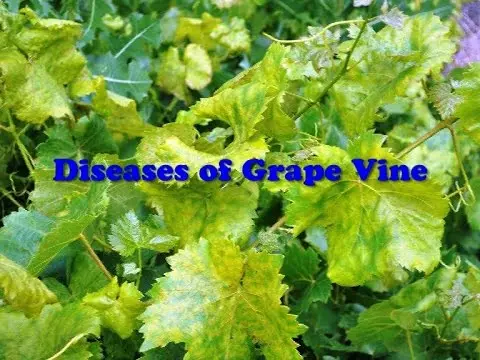Diseases of grapes are a serious obstacle to the growth and development of a plant. They are divided into infectious, capable of being transmitted from a diseased plant to a healthy one, and non-infectious, the cause of which may be associated with the condition of the soil, mechanical damage, and weather conditions.
Mildew grape disease
Mildew is a dangerous fungal disease that affects vineyards in many growing areas, except in hot and dry climates. This disease spreads to all green parts of the bush during the growing season. In winter, the spores of the fungus remain in the fallen leaves of the plant. With the onset of spring and an increase in temperature to +10 degrees, as well as with sufficient soil moisture, primary zoosporangia are formed. They fall on the surface of the leaves with the help of rain and wind, then burst, and mobile zoospores easily reach the stomata – this is how the primary infection occurs.
During the entire growing season, mildew is capable of giving more than 20 generations. Sporulation with mildew develops especially actively at high humidity – more than 90%, and at temperatures from 13 degrees. At a higher temperature, from 22-26 degrees, the mushroom grows even more.
Grapes will be less affected by mildew if dill is planted around it
Young leaves are affected by rounded yellow spots that begin to cover the entire leaf. During wet weather, spots on the lower part of the leaves are covered with white fluff. Then the leaves begin to turn yellow and fall off. On the shoots of grapes infected with mildew, dotted brownish spots appear. Particularly harmful is the defeat of young seedlings and inflorescences by the disease, sporulation of the fungus occurs on them. The inflorescence dies, and the berries begin to turn black, wrinkle and fall off. The development of the disease stops if the temperature rises above 30 degrees.
For the treatment of mildew, it is necessary to eliminate the primary lesions and treat the grapes with pesticides in time. Before flowering, the plant must be sprayed with 1 or 2 percent Bordeaux liquid. The next processing should be carried out after the berries have become the size of a match head.
Instead of Bordeaux liquid, you can use arcerid, polychem, polycarbacin, copper chloride
Anthracnose grape disease
Anthracnose (grape pox) affects the shoots, leaves, inflorescences and berries of the plant. First, light gray spots are formed on young leaves, around which there is a reddish or dark brown rim. After that, the tissues affected by the disease fall out, and holes remain on the sheet. On young shoots, brownish spots appear, which begin to be pressed in, merge and form ulcers. On ripe berries, the formation of depressed brown spots with a dark purple border occurs.
The peak of development of anthracnose occurs at the beginning of the growing season of grapes. Affected plants lose many leaves, berries ripen poorly on them. In case of severe damage, the grapes may die completely. The following measures will help to treat grape pox: – airing the plants; – timely tying of bushes; – removal of unnecessary shoots; – elimination of weeds. The leaves affected by the disease must be burned, and the same should be done after the autumn pruning with foliage and the remnants of the vine. Digging row spacings also helps to reduce the disease. During the growing season, it is necessary to spray the grapes with a 1% solution of Bordeaux liquid, be sure to treat the lower part of the leaf, since the disease develops here.
Black rot grape disease
The causative agent of black rot is the gingnardia fungus, which overwinters in the soil or on the vine of the plant. Disease infection begins after rain. Black rot affects the berries, leaves and shoots of grapes. Small brown, depressed spots appear on green fruits. Over time, they acquire a purple hue and spread throughout the berry, which then dries up, turns black and falls off. Leaves and shoots are affected by brown spots with a black border.
It is necessary to fight black rot by spraying with Bordeaux liquid. For the first time, the procedure should be carried out before flowering, then after flowering and two weeks after the second treatment.
Chlorosis grape disease
In plants with chlorosis, the clusters are usually loose with small berries, the shoots ripen poorly and have shortened internodes. The cause of the disease may be a disturbance in plant nutrition, excessive soil moisture, the proximity of subsoil waters, severe drought and excess lime in the soil.
The fight against chlorosis in fruiting plants is reduced to timely feeding them with mineral fertilizers, loosening and watering. In autumn, iron vitriol is added to calcareous soils, 600-800 g for each bush. In the summer, the sleeves and the head of the bushes are treated with a 1% solution of ferrous sulfate. At the same concentration, it is applied directly to the soil, 3 liters per bush.
Protection of grapes from disease
Grape aphids
In addition to diseases, grapes are attacked by pests, one of which is the grape aphid (phylloxera). This insect pierces the roots of a plant with its proboscis and absorbs nutrients, secretes enzymes that disrupt normal physiological processes. Aphids are the cause of many infectious diseases of grapes and the causative agent of decay. Bulges appear on the roots of the plant, it grows poorly, the yield decreases, and later the grapes die.
To protect the plant from the grape aphid, it is necessary to cut the root shoots and tops, loosen the soil in a timely manner and carefully examine the planting plants. To kill aphids, plants are sprayed with organophosphorus compounds and neoncotinoids.










